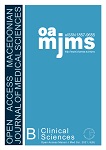Evaluation of Extreme Hip Joint Movement after Total Hip Arthroplasty: A Retrospective Study
DOI:
https://doi.org/10.3889/oamjms.2021.6528Keywords:
Total hip arthroplasty, Functional outcome, Extreme hip movementAbstract
Introductions: The number of total hip arthroplasty (THA) is increased every year in our country. Mobility ofthe hip joint after THA is important to achieve. Subject’s expectation to perform daily activity, moreoverextreme hip movement are crucial for some particular populations. This study aimed to evaluate patient’s functional outcome and ability to peform extreme hip joint movement. Methods: This is a retrospective study of patients who received total hip arthroplasty in our center. Evaluated factors Include age, gender, body mass Index (BMI), socio-economic status, diagnosis, physical therapy, radiographic acetabular inclination, acetabular cup diameter, and head diameter. Clinical evaluation performed with Harris hip score (HHS). Extreme hip joint movement evaluation performed with patient’s ability to perform squatting and Salat (Muslim prayer). The chi-square and mann-whitney tests were used for data analysis. Results: We collected data from a total of 22 subjects. All patients (100%) could perform squatting postoperatively. Among the subjects, therewere 11 patients (11/22, 50%) could perform Salat activity in excellent manner, while the rest (11 patients)need some modification of movement during Salat activity. All patients have significant improvement of Harris hip score compared to preoperative condition. Further, we tried to compare factors between the two group for possible difference. No significant difference in age, gender, BMI, comorbidities, preoperative diagnosis between two group of patients. Conclusions: Subject receiving THA can be expected to perform extreme hip joint movement post-operatively. However, some patients still could not perform Salat activity in excellent manner. Age, gender, BMI, and comorbidities seem to be had no effect on the patient’s ability to performextreme hip movement post-operatively.
Downloads
Metrics
Plum Analytics Artifact Widget Block
References
Brown TD, Elkins JM, Pedersen DR, Callaghan JJ. Impingement and dislocation in total hip arthroplasty: Mechanisms and consequences. Iowa Orthop J. 2014;34:1-15. PMid:25328453
Sugano N, Tsuda K, Miki H, Takao M, Suzuki N, Nakamura N. Dynamic measurements of hip movement in deep bending activities after total hip arthroplasty using a 4-dimensional motion analysis system. J Arthroplasty. 2012;27(8):1562-8. https://doi.org/10.1016/j.arth.2012.01.029 PMid:22459125 DOI: https://doi.org/10.1016/j.arth.2012.01.029
Saputra E, Anwar IB, Jamari J Finite element analysis of artificial hip joint movement during human activities. Proc Eng. 2013;68:102-8. http://doi.org/10.1016/j.proeng.2013.12.154 DOI: https://doi.org/10.1016/j.proeng.2013.12.154
Yoshimine F, Ginbayashi K. A mathematical formula to calculate the theoretical range of motion for total hip replacement. J Biomech. 2002;35(7):989-93. https://doi.org/10.1016/s0021-9290(02)00040-4 DOI: https://doi.org/10.1016/S0021-9290(02)00040-4
Vincent HK, Alfano AP, Lee L, Vincent KR. Sex and age effects on outcomes of total hip arthroplasty after inpatient rehabilitation. Arch Phys Med Rehabil. 2006;87(4):461-7. https://doi.org/10.1016/j.apmr.2006.01.002 PMid:16571383 DOI: https://doi.org/10.1016/j.apmr.2006.01.002
Buirs LD, Van Beers LW, Scholtes VA, Pastoors T, Sprague S, Poolman RW. Predictors of physical functioning after total hip arthroplasty: A systematic review. BMJ Open. 2016;6(9):e010725. https://doi.org/10.1136/bmjopen-2015-010725 PMid:27601486 DOI: https://doi.org/10.1136/bmjopen-2015-010725
Hakim Z, Rutherford C, Mckiernan E, Helm T. Outcome in patients with high body mass index following primary total hip arthroplasty. Adv Orthop Surg. 2015;2015:1-4. https://doi.org/10.1155/2015/758486 DOI: https://doi.org/10.1155/2015/758486
Polat G, Ceylan HH, Sayar S, Kucukdurmaz F, Erdil M, Tuncay I. Effect of body mass index on functional outcomes following arthroplasty procedures. World J Orthop. 2015;6(11):991-5. https://doi.org/10.5312/wjo.v6.i11.991 PMid:26716096 DOI: https://doi.org/10.5312/wjo.v6.i11.991
Kelley SS, Lachiewicz PF, Hickman JM, Paterno SM. Relationship of femoral head and acetabular size to the prevalence of dislocation. Clin Orthop Relat Res. 1998;355:163-70. https://doi.org/10.1097/00003086-199810000-00017 PMid:9917601 DOI: https://doi.org/10.1097/00003086-199810000-00017
Peter R, Lübbeke A, Stern R, Hoffmeyer P. Cup size and risk of dislocation after primary total hip arthroplasty. J Arthroplasty. 2011;26(8):1305-9. https://doi.org/10.1016/j.arth.2010.11.015 PMid:21414747 DOI: https://doi.org/10.1016/j.arth.2010.11.015
Singh SP, Bhalodiya HP. Head size and dislocation rate in primary total hip arthroplasty. Indian J Orthop. 2013;47(5):443-8. https://doi.org/10.4103/0019-5413.118198 PMid:24133302 DOI: https://doi.org/10.4103/0019-5413.118198
Soong M, Rubash HE, Macaulay W. Dislocation after total hip arthroplasty. J Am Acad Orthop Surg. 2004;12(5):314-21. https://doi.org/10.5435/00124635-200409000-00006 PMid:15469226 DOI: https://doi.org/10.5435/00124635-200409000-00006
Zahar A, Rastogi A, Kendoff D. Dislocation after total hip arthroplasty. Curr Rev Musculoskelet Med. 2013;6(4):350-6. https://doi.org/10.1007/s12178-013-9187-6 PMid:24170479 DOI: https://doi.org/10.1007/s12178-013-9187-6
Turley GA, Williams MA, Wellings RM, Griffin DR. Evaluation of range of motion restriction within the hip joint. Med Biol Eng Comput. 2013;51(4):467-77. https://doi.org/10.1007/s11517-012-1016-3 PMid:23263850 DOI: https://doi.org/10.1007/s11517-012-1016-3
Zhou H, Wang CT, Ji WT, Zeng X Sen, Fang S, et al. Motion performance and impingement risk of total hip arthroplasty with a simulation module. J Zhejiang Univ Sci B. 2013;14(9):849-54. https://doi.org/10.1631/jzus.b1200168 PMid:24009206 DOI: https://doi.org/10.1631/jzus.B1200168
Downloads
Published
How to Cite
License
Copyright (c) 2020 Iwan Budiwan Anwar, Emile van der Heide, J. Jamari, Eko Saputra, Asep Santoso, Denny Adriansyah, Zarkasyi Arimukti (Author)

This work is licensed under a Creative Commons Attribution-NonCommercial 4.0 International License.
http://creativecommons.org/licenses/by-nc/4.0








